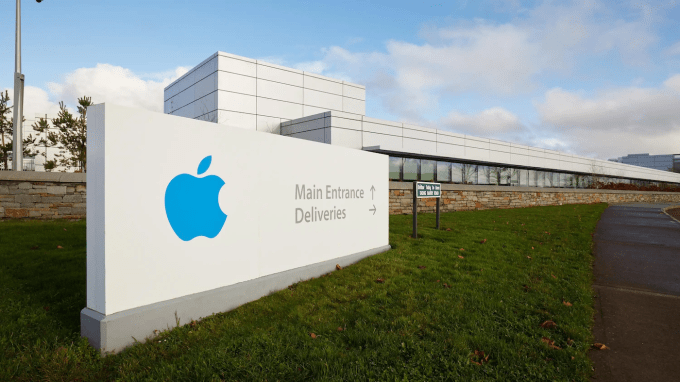US technology giant, Apple has lowered its fiscal 2019 Q1 guidance, following weaker than expected iPhone sales and a weakening economy in China.
In a letter, Apple CEO Tim Cook told investors that the company expects revenue to stand at approximately $84 billion with a gross margin of approximately 38%. Operating expenses are projected to stand at approximately $8.7 billion with other income/(expense) expected to be approximately $550 million. Apple expects a tax rate of approximately 16.5 percent before discrete items
“We expect the number of shares used in computing diluted EPS to be approximately 4.77 billion. Based on these estimates, our revenue will be lower than our original guidance for the quarter, with other items remaining broadly in line with our guidance. While it will be a number of weeks before we complete and report our final results, we wanted to get some preliminary information to you now. Our final results may differ somewhat from these preliminary estimates,” said Cook.
“When we discussed our Q1 guidance with you about 60 days ago, we knew the first quarter would be impacted by both macroeconomic and Apple-specific factors. Based on our best estimates of how these would play out, we predicted that we would report slight revenue growth year-over-year for the quarter,” he added.
Cook said they had anticipated that the timing of its iPhone launches would affect year-over-year compares.
“Our top models, iPhone XS and iPhone XS Max, shipped in Q4’18—placing the channel fill and early sales in that quarter, whereas last year iPhone X shipped in Q1’18, placing the channel fill and early sales in the December quarter. We knew this would create a difficult compare for Q1’19, and this played out broadly in line with our expectations. Second, we knew the strong US dollar would create foreign exchange headwinds and forecasted this would reduce our revenue growth by about 200 basis points as compared to the previous year. This also played out broadly in line with our expectations,” he said.
In addition, there was an unprecedented number of new products to ramp during the quarter and predicted that supply constraints would gate Apple’s sales of certain products during Q1. This also played out broadly in line with our expectations. Sales of Apple Watch Series 4 and iPad Pro were constrained much or all of the quarter. AirPods and MacBook Air were also constrained.
According to Cook, economic weakness in some emerging markets had a significantly greater impact than the company had projected contributing to fewer iPhone upgrades than it had been anticipated.
“While we anticipated some challenges in key emerging markets, we did not foresee the magnitude of the economic deceleration, particularly in Greater China. In fact, most of our revenue shortfall to our guidance, and over 100 percent of our year-over-year worldwide revenue decline, occurred in Greater China across iPhone, Mac and iPad,” he said.
Cook noted that China’s economy began to slow in the second half of 2018 with the government-reported GDP growth during the September quarter being the second lowest in the last 25 years.
“We believe the economic environment in China has been further impacted by rising trade tensions with the United States. As the climate of mounting uncertainty weighed on financial markets, the effects appeared to reach consumers as well, with traffic to our retail stores and our channel partners in China declining as the quarter progressed. And market data has shown that the contraction in Greater China’s smartphone market has been particularly sharp,” he said.
Despite these challenges, he said Apple believes that its business in China has a bright future, noting that the iOS developer community in China is among the most innovative, creative and vibrant in the world.
“Our products enjoy a strong following among customers, with a very high level of engagement and satisfaction. Our results in China include a new record for Services revenue, and our installed base of devices grew over the last year. We are proud to participate in the Chinese marketplace,” he said.
“Lower than anticipated iPhone revenue, primarily in Greater China, accounts for all of our revenue shortfall to our guidance and for much more than our entire year-over-year revenue decline. In fact, categories outside of iPhone (Services, Mac, iPad, Wearables/Home/Accessories) combined to grow almost 19 percent year-over-year. While Greater China and other emerging markets accounted for the vast majority of the year-over-year iPhone revenue decline, in some developed markets, iPhone upgrades also were not as strong as we thought they would be. While macroeconomic challenges in some markets were a key contributor to this trend, we believe there are other factors broadly impacting our iPhone performance, including consumers adapting to a world with fewer carrier subsidies, US dollar strength-related price increases, and some customers taking advantage of significantly reduced pricing for iPhone battery replacements,” he added.
Cook said while it is disappointing to revise Apple’s guidance, its performance in many areas showed remarkable strength in spite of these challenges.
“Our installed base of active devices hit a new all-time high—growing by more than 100 million units in 12 months. There are more Apple devices being used than ever before, and it’s a testament to the ongoing loyalty, satisfaction and engagement of our customers. Also, as I mentioned earlier, revenue outside of our iPhone business grew by almost 19 percent year-over-year, including all-time record revenue from Services, Wearables and Mac. Our non-iPhone businesses have less exposure to emerging markets, and the vast majority of Services revenue is related to the size of the installed base, not current period sales,” he said.
Services generated over $10.8 billion in revenue during the quarter, growing to a new quarterly record in every geographic segment, Cook revealed, adding Apple is on track to achieve its goal of doubling the size of this business from 2016 to 2020.
Wearables grew by almost 50% year-over-year, as Apple Watch and AirPods were wildly popular among holiday shoppers; launches of MacBook Air and Mac mini powered the Mac to year-over-year revenue growth and the launch of the new iPad Pro drove iPad to year-over-year double-digit revenue growth.
“We also expect to set all-time revenue records in several developed countries, including the United States, Canada, Germany, Italy, Spain, the Netherlands and Korea. And, while we saw challenges in some emerging markets, others set records, including Mexico, Poland, Malaysia and Vietnam,” Cook said.
READ: BRITAM ISSUES PROFIT WARNING
He added Apple expects to report a new all-time record for Apple’s earnings per share.
Looking Ahead, Cook said Apple’s profitability and cash flow generation are strong, and the company expects to exit the quarter with approximately $130 billion in net cash. As we have stated before, we plan to become net-cash neutral over time.













Leave a comment